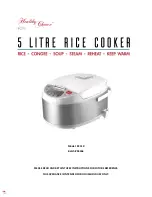
23
TABLE N° 5
No.of Setting
POSSIBLE COOKING METHODS
0 Plate
off
1
To melt butter, chocolate, etc. – To heat small amounts of liquid
2
To heat larger quantities of liquid - To prepare creams and sauces That required extended cooking
3
To defrost foods, cook at boiling temperature
4
To cook roasts with delicate meat and fish
5
For meat roasts and steaks, for large pieces of boiled meat
6
To boil large quantities of water, for frying
To ensure correct use, remember the following:
- Dry the bottom of the pot before placing it on the plate.
- Use pots with a flat and thick bottom (see Fig. 25).
- Never use pots that are smaller than the plate.
- Turn on the plate only after the pot has been placed on top.
- As soon as a crack appears on the surface of the hot plate, immediately turn off the appliance.
- If the appliance is equipped with a glass cover, it may break when heated.
- Turn off all the plates before closing the cover.
- After use, and to ensure good preservation, the plate should be treated with normal products for electric hot
plates that are available in the market so that the surface is always clean; this operation will prevent any
corrosion (rust).
- After they are used, the plates remain hot for a long time; therefore, do not place the hands or other objects
on the plate to avoid burns.
- When using the burners, make sure that the handles of the pots are correctly positioned. Keep children away
from the appliance.- When cooking foods with oil and fat, which are very flammable, the user should remain
near the appliance.
WARNING: As soon as a crack appears on the surface of the hot plate, immediately turn off the appliance.
USING THE GAS OVEN
GAS OVEN:
All the gas oven cookers are equipped with a thermostat and safety device to adjust the cooking temperature. The oven
temperature is set by turning the knob counterclockwise to match the indicator with the temperature selected. The gas
oven can be combined with a gas grill or an electric grill. See the specific pages for use information.
FAN GAS OVEN:
Operating the fan of the oven by means of the appropriate switch situated on the control panel, the circulation of
warm air guarantees a uniform heat distribution. The preheating of the oven can be avoided. However for delicate
baking, it is preferable to warm the oven before introducing the baking-pan. The baking system with the fan
convection changes in part the various traditional baking notions. When roasting meat it is not necessary to turn
the meat any more and for a roast on the spit, it is not indispensable to use the spit-roaster,
but is sufficient to put the meat directly on the grate.
With the use of the fan gas oven, the baking temperatures are slightly lower of about 10-15°C compared to those
in use with the traditional gas oven. The fan operation of the oven prevents the operation of the electric grill, which
therefore cannot be used with the fan in action.
The oven can also be used in a traditional way, (by not activating the fan) for foods requiring heat from the bottom,
e.g. pizza.
WARNING: If the burner flames are extinguished accidentally, turn off the control knob and do not try to relight
the oven until after at least 1 minute.
TABLE N°6
THERMOSTAT SETTING
TEMPERATURE °C
1 120°C
2 140°C
3 160°C
4 180°C
5 200°C
6 225°C
7 245°C
8 270°C
The oven burner can be ignited in different ways:
- Manual lighting
(it is always possible even when the power is cut off):
To light the oven, open the oven door, push and turn the knob so the no. 8 on the scale matches the indicator (fig.26-
27-28). At the same time put a lit match next to the ignition tube that is visible on the oven level (fig.30). Then press the
thermostat knob (this makes the gas start to flow) and keep it pressed, after the burner has been completely lit, for 10
seconds. Release the knob and make sure that the burner remains on, otherwise repeat the operation.
Summary of Contents for MG
Page 46: ...46 Fig 3 Fig 4 Fig 5 Fig 6 Fig 7 Fig 8 Fig 9 Fig 10 Fig 11 Fig 12...
Page 47: ...47 Fig 13 Fig 14 Fig 15 T Fig 16 Fig 17 Fig 18 Fig 19 Fig 20 Fig 21 Fig 22 Fig 23 Fig 24...
Page 48: ...48 Fig 25 Fig 26 Fig 27 Fig 28 Fig 29 Fig 30 Fig 31 Fig 32 Fig 33 Fig 34 Fig 35 Fig 36 Fig 37...
Page 49: ...49 Fig 38 Fig 39 Fig 40 Fig 41 Fig 42 Fig 43 Fig 44 Fig 45 Fig 46 Fig 47...
Page 50: ...50...
Page 51: ...51...
Page 52: ...52 Cod 310226...
















































